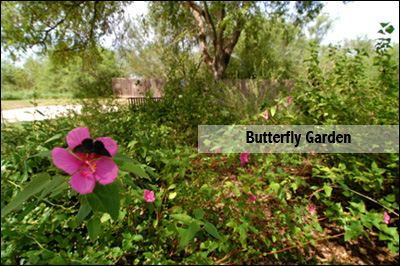Welcoming Wild Things (Native Gardening)

By Cecilia Nasti
Once humans started transforming thriving wildlife habitat into similarly thriving suburban neighborhoods and retail centers, indigenous species began to have difficulty locating appropriate sources of food, water and shelter. They had to either adapt to the new conditions or move on. Fortunately, homeowners have started to embrace the concept of wildscaping, which makes it possible for wildlife to coexist with the likes of us; and our lives are richer for it.
Wildscaping is gardening with wildlife in mind. This doesn’t mean allowing the grass and weeds to grow so high the neighborhood association gets involved. What it does mean is creating areas in your yard that supply the basics of food, water and shelter so wildlife will come for a visit or come for good.
Texas Parks and Wildlife Department Urban Biologist Kelly Bender, co-author of Texas Wildscapes: Gardening for Wildlife, says the first step toward creating a wildscape is to establish wildlife goals. “If you want to watch hummingbirds during migration, for example, start planting things that bloom in fall and spring, especially those things that are adapted for the birds, like coral honeysuckle and some of the salvias.”
The next step is to create a plan. This will be your best friend as you transition from exotic plants to native species. Include an assessment of what you already have in your yard. Keep native plants that serve you and wildlife, and dispatch the others. “Just because something is growing in your yard that you didn’t plant doesn’t make it a native,” says Bender.
The key to wildscaping success is variety and layering. Canopy, understory and groundcover is vital as many species require specific habitat. Bender says the low tangle of vegetation homeowners usually clear out is also valuable.
Sketch out a diagram of the entire yard, blocking out the areas where you want the wildlife to frequent. “For example,” says Bender, “you can say, ‘I want hummingbirds here and butterflies there.’ Function comes before plant selection.” Once you have your plan and diagram, remember to start small. By starting small and gradually replacing exotics with low water-use native plants that provide flowers, fruits, seeds and leaves for the benefit of wildlife, you give yourself time to adjust to the new landscape.
Although birdbaths are a terrific way to provide water to some visiting wildlife, if you want to attract a greater diversity of animal life to your yard, Bender says variety is the key. “Vary the depth of water. Have it shallow in some areas, deeper in others and even with a gentle slope. Different animals have different needs.”
The difference between wildlife visitors and wildlife residents involves the availability of suitable shelter. Bender says something sorely lacking in our suburban backyards are cavities — little holes in trees. “Standing dead trees are called snags,” says Bender, “and if a homeowner has a snag in their yard that’s not endangering life or property, they should keep it. Standing dead trees are not only important sources of shelter, but also valuable sources of food for songbirds. The soft wood harbors insects, so it’s a substrate for those. Standing dead trees can be more important to wildlife than live ones since they are such a limited resource.”
To learn more about getting started with your wildscaping project, visit www.tpwd.state.tx.us/huntwild/wild/wildscapes/, where you will find plant lists as well as contact information for urban biologists in your area. They hold classes that cover the basics of creating a welcoming environment for wildlife.
This article appeared in the January 2005 issue of Texas Parks & Wildlife. If you’d like to read more articles like this or subscribe to the magazine, visit www.tpwmagazine.com/.
 Texas Parks and Wildlife Department, 4200 Smith School Road, Austin, TX 78744
Texas Parks and Wildlife Department, 4200 Smith School Road, Austin, TX 78744


